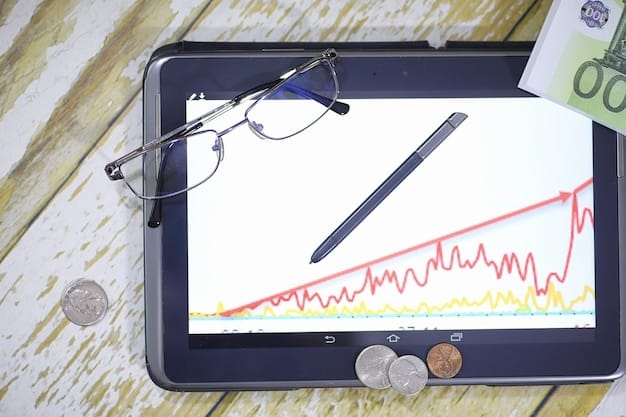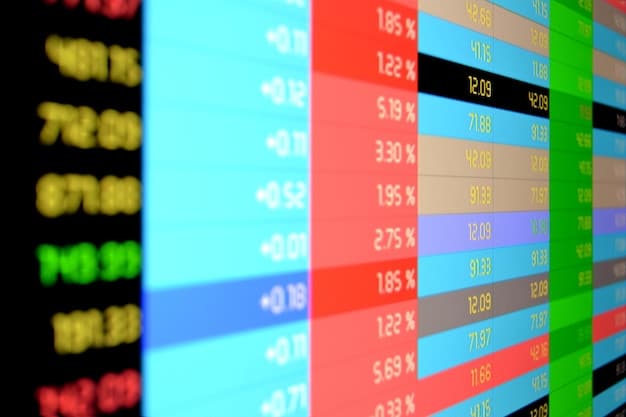Investing in ETFs: A Beginner’s Guide to Low-Cost Diversification

Investing in ETFs offers a simple and cost-effective way to diversify your investment portfolio across various asset classes, sectors, or geographic regions, making it an accessible option for both beginner and experienced investors.
Anúncios
Are you looking for a straightforward and affordable way to diversify your investment portfolio? Understanding investing in ETFs (Exchange Traded Funds) can be a great starting point, offering diversification benefits at a low cost and ease of trading.
Understanding the Basics of ETFs
Exchange Traded Funds (ETFs) have become increasingly popular among investors of all levels. Understanding what they are and how they work is crucial before you consider investing in them. Let’s delve into the fundamental aspects of ETFs that every beginner needs to know.
What is an ETF?
An ETF is essentially a basket of securities that tracks an underlying index, sector, commodity, or other asset. Unlike mutual funds, ETFs can be bought and sold on stock exchanges like individual stocks.
How Do ETFs Work?
ETFs operate by holding a collection of assets that mirror the composition of a specific index. When you buy an ETF share, you’re buying a small piece of all the underlying investments represented in that index.
- Diversification: ETFs offer instant diversification, spreading your investment across multiple assets and reducing risk.
- Low Cost: Generally, ETFs have lower expense ratios compared to actively managed mutual funds.
- Transparency: ETF holdings are typically disclosed daily, providing investors with clear insights into their investments.
ETFs provide an attractive alternative for those seeking diversified exposure to specific markets or sectors without the need to pick individual stocks. Remember to always consider your investment goals and risk tolerance.
Why Choose ETFs for Diversification?
Diversification is a cornerstone of sound investment strategy. ETFs make diversification accessible and affordable; however, it’s important to understand the benefits. Here are compelling reasons why ETFs are an excellent tool for diversifying your portfolio.
Instant Diversification
With a single ETF, you gain exposure to a wide array of assets. This instant diversification helps mitigate risk because your investment isn’t solely reliant on the performance of one company or sector.
Access to Various Markets and Sectors
ETFs enable you to invest in specific industries, geographic regions, or asset classes that might be difficult for individual investors to access directly.
- Broad Market Exposure: Invest in ETFs that track major market indexes like the S&P 500.
- Sector-Specific ETFs: Target specific sectors like technology, healthcare, or energy.
- International ETFs: Diversify globally by investing in ETFs that focus on different countries or regions.
ETFs offer a simple and efficient way to achieve broad diversification, reducing your portfolio’s vulnerability to market fluctuations and potentially enhancing long-term returns.
Understanding ETF Costs and Fees
While ETFs are known for their low-cost structure, it’s important to understand the costs involved before you invest. Being aware of these fees can help you make informed decisions and maximize your investment returns. Let’s break down the key costs associated with ETF investing.
Expense Ratio
The expense ratio is an annual fee charged by the ETF to cover its operating expenses. It’s typically a small percentage of your investment, but it can add up over time. Be sure to compare expense ratios among similar ETFs to find the most cost-effective option.
Trading Costs
Whenever you buy or sell ETF shares, you may incur trading commissions from your broker. Some brokers offer commission-free ETF trading, which can significantly reduce your overall investment costs.
- Commissions: Check if your broker charges a commission for each ETF trade.
- Bid-Ask Spread: The difference between the highest price a buyer is willing to pay (bid) and the lowest price a seller is willing to accept (ask). Smaller spreads are generally more favorable.
- Hidden Costs: Some ETFs may have additional costs, such as management fees or transaction fees, so read the prospectus carefully.
By understanding and minimizing these costs, you can improve your overall investment performance and keep more of your returns.
How to Choose the Right ETFs
With thousands of ETFs available, selecting the right ones for your portfolio can seem daunting. Consider these aspects to make informed choices and ensure they align with your financial goals and risk tolerance.
Define Your Investment Goals
Determine what you want to achieve with your investments. Are you saving for retirement, a down payment on a house, or another specific goal? Your investment goals will help you identify the types of ETFs that are most suitable for your needs.
Assess Your Risk Tolerance
Understand how much risk you’re comfortable taking. If you’re risk-averse, you might prefer ETFs that invest in stable, low-volatility assets. If you have a higher risk tolerance, you might consider ETFs that invest in growth-oriented sectors or emerging markets.
- Research ETF Holdings: Look into the underlying assets of the ETF to understand its risk profile.
- Evaluate Past Performance: While past performance is not indicative of future results, it can provide insight into how the ETF has performed under different market conditions.
- Read the Prospectus: The ETF prospectus contains important information about the fund’s investment objectives, strategies, risks, and expenses.
Choosing the right ETFs involves a thorough assessment of your investment goals, risk tolerance, and careful research of the available options. Take your time and consult with a financial advisor if needed.
Strategies for Investing in ETFs
Once you’ve selected the right ETFs, it’s time to develop an investment strategy. Implementing a well-thought-out approach can help you achieve your financial goals and manage risk effectively. Here are some strategies to consider.
Dollar-Cost Averaging
Dollar-cost averaging involves investing a fixed amount of money at regular intervals, regardless of the ETF’s share price. Time the market, but rather, buy regularly which helps to reduce the impact of volatility.
Rebalancing Your Portfolio
Over time, your portfolio’s asset allocation may drift away from your target due to market fluctuations. Rebalancing involves selling some assets and buying others to bring your portfolio back to its desired allocation.
- Set a Rebalancing Schedule: Decide how often you will rebalance your portfolio, such as quarterly, annually, or whenever your asset allocation deviates significantly from your target.
- Consider Tax Implications: Be mindful of the tax consequences of selling investments in a taxable account.
- Diversify Your Investments: Make sure to spread investments across different asset classes to manage risk effectively.
By implementing these strategies, you can enhance your investment returns, manage risk, and stay on track toward achieving your financial goals.
Tax Implications of ETF Investing
Understanding the tax implications of ETF investing is crucial for maximizing your after-tax returns. Different types of investment accounts and ETF structures can have varying tax consequences. Let’s explore some key considerations.
Tax-Advantaged Accounts
Consider holding your ETFs in tax-advantaged accounts such as 401(k)s, IRAs, or Roth IRAs. These accounts offer tax benefits such as tax-deferred growth or tax-free withdrawals, which can significantly boost your long-term returns.
Capital Gains Tax
When you sell ETF shares for a profit in a taxable account, you may be subject to capital gains tax. The tax rate depends on how long you held the shares. Short-term capital gains (held for one year or less) are taxed at your ordinary income tax rate, while long-term capital gains (held for more than one year) are taxed at a lower rate.
- Tax-Loss Harvesting: If you have ETFs that have declined in value, you may be able to use tax-loss harvesting to offset capital gains. This involves selling the losing investments and immediately buying similar investments to maintain your portfolio’s asset allocation.
- Qualified Dividends: Some ETFs pay qualified dividends, which are taxed at a lower rate than ordinary income.
- Consult a Tax Professional: Tax laws can be complex and subject to change. Consult with a qualified tax professional to develop a tax-efficient investment strategy tailored to your specific circumstances.
Understanding and managing the tax implications of ETF investing will help you minimize your tax liabilities and keep more of your hard-earned returns.
| Key Point | Brief Description |
|---|---|
| diversificaçãoDiversification | ETFs combine the resources into a single basket of securities. |
| 💸 Lower Cost | ETFs can potentially save you money in the longer run. |
| 📊 Transparency | ETF holdings are typically disclosed everyday for insights. |
| 🎯 Multiple Markets | Gain entry to a range of areas and sectors. |
Frequently Asked Questions About ETF Investing
▼
An ETF (Exchange Traded Fund) is much like a mutual fund, holding a basket of assets, but it trades on stock exchanges like individual stocks. Unlike mutual funds, ETFs offer intra-day liquidity and typically have lower expense ratios.
▼
▼
▼
While ETFs provide diversification, they are not without risk. Market risk, sector-specific risk, and tracking error are all possible. It is thus important to assess ones risk tolerance. Diversification does not guarantee against loss.
▼
Your ETF portfolio must always be aligned with your goals. So review it on a schedule quarterly or annually to ensure it is on par with your expectations and make any needed adjustments.
Conclusion
Investing in ETFs offers a compelling blend of diversification, low cost, and accessibility, making them a valuable tool for both novice and experienced investors. By understanding the basics, evaluating your options, and implementing a thoughtful investment strategy, you can use ETFs to build a well-diversified portfolio that aligns with your financial goals.







